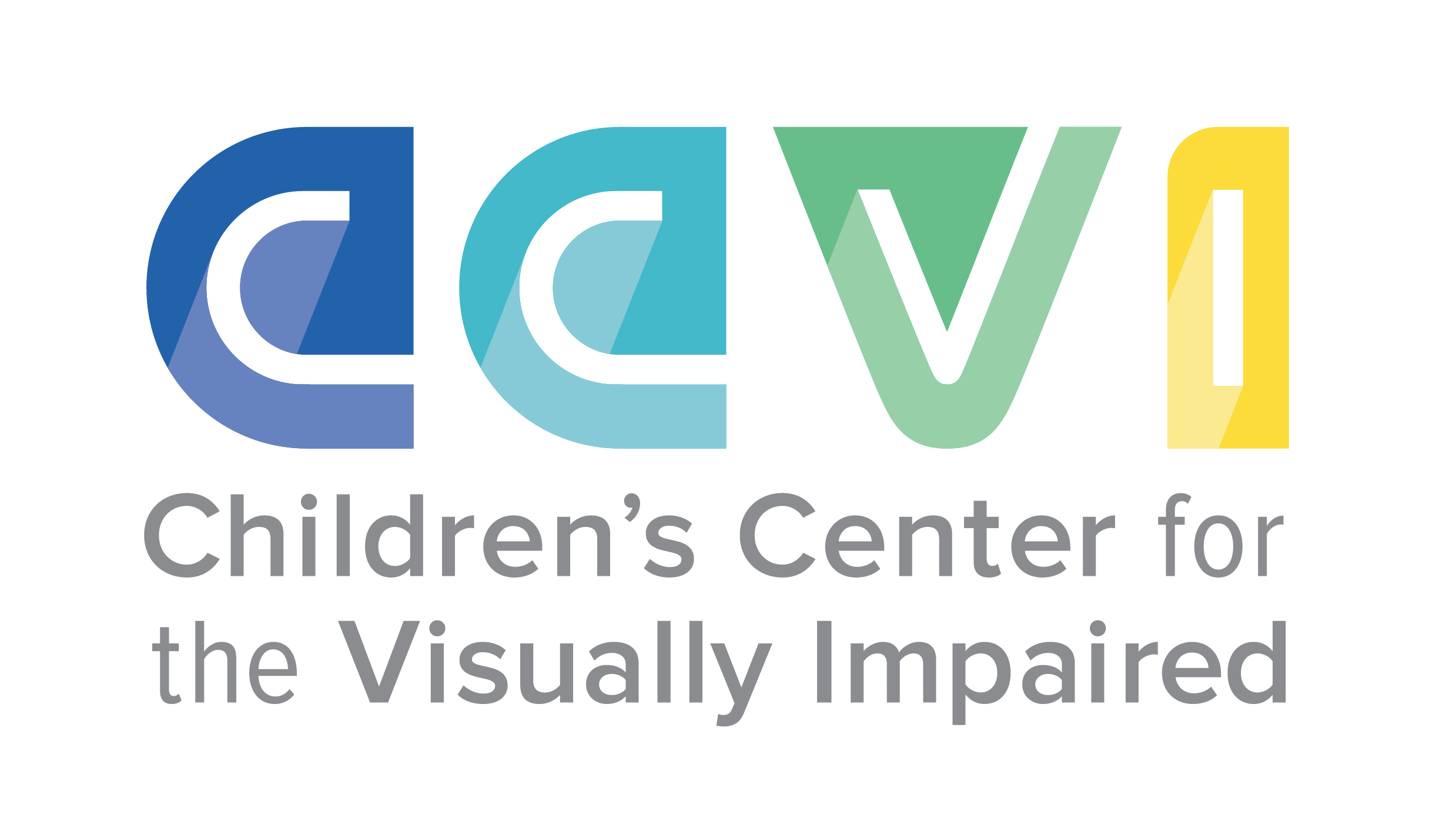
Care starts
with understanding
Overview
Visual Impairment may seem like a complex condition that is tough to relate to. However, gathering knowledge about the subject is the first step towards understanding. With a thorough background and access to comprehensive information, you can be an ally for CCVI students.
Help inspire societal change for individuals with visual impairment in order to build a future where everyone can thrive.
Explore a variety of toolkits and informational guides about visual impairments and blindness that help connect sighted individuals with children at CCVI. Discover the three items in a child’s toolbelt to compensate for their vision and how these resources propel them into their educational future and adult lives.
Facts about Visual Impairments
RANGE OF BLINDNESS
Vision good enough to travel unaided
Minimal vision at close range
Light perception
Total blindness
CAUSES OF BLINDNESS
Diseases
Hereditary conditions
Age-related conditions
Accidents

Things to Know
Children are functionally blind if they are totally blind or if the best corrected visual acuity in their better eye is not better than light perception.
Children are visually impaired if they are not legally blind, but their best corrected central visual acuity does not exceed 20/70 or if the maximum angular diameter of their visual field does not exceed 30 degrees even if their best corrected visual acuity in their better eye exceeds 20/70.
Children who are blind or visually impaired may learn to read through the use of Braille, large print, a magnifier or recorded materials. They may also learn to write in Braille or in handwriting.
Blindness occurs in an estimated one to two percent of the population (ages 0-20 years).
With vision loss, the other senses do not automatically become more acute; a person simply learns to use them more fully.
Total blindness occurs when a child is unable to visually detect light of any intensity. Light perception occurs if, with their better eye, a child can detect light and determine from which direction it’s coming.
Children who are legally blind have a best corrected central visual acuity in their better eye that does not exceed 20/200 and/or a visual field whose maximum angular diameter does not exceed 20 degrees.
Common Causes in Children
CORTICAL VISUAL IMPAIRMENT
Cortical Visual Impairment (CVI) is a temporary or permanent visual impairment caused by the disturbance of the posterior visual pathways and/or the occipital lobes of the brain. The degree of vision impairment can range from mild to severe visual impairment. The degree of neurological damage and visual impairment depends upon the time of onset, as well as the location and intensity of the insult. It is a condition that indicates that the visual systems of the brain do not consistently understand or interpret what the eyes see. The presence of CVI is not an indicator of the child’s cognitive ability. The terms Cortical Visual Impairment, Neurological Visual Impairment and Cerebral Visual Impairment are sometimes used interchangeably.
RETINOPATHY OF PREMATURITY
Retinopathy of Prematurity (ROP) is a condition associated with premature birth, in which the growth of normal blood vessels in the retina (a light-sensitive membrane in the back of the eye containing rods and cones that receive an image from the lens and send it to the brain through the optic nerve) stops, and abnormal blood vessels develop. As a result, the infant has an increased risk of detachment of the retina. ROP can lead to reduced vision or blindness.
OPTIC NERVE HYPOPLASIA
Optic Nerve Hypoplasia (ONH) refers to the underdevelopment of the optic nerve during pregnancy. The dying of optic nerve fibers as the child develops in utero is a natural process, and ONH may be an exaggeration of that process. ONH may occur infrequently in one eye (unilateral), but more commonly in both eyes (bilateral). ONH is not progressive, is not inherited and cannot be cured. However, depending on the degree of visual impairment, a person with this condition may benefit from the use of devices for low vision. The effects of ONH have a broad range, from little or no visual impairment to near-total blindness. ONH is one of the three most common causes of visual impairment in children.
ALBINISM
Albinism is a congenital condition that affects the pigmentation and color of the eyes and may also affect the skin and hair. Most patients with albinism have a very high degree of vision and are some of the best candidates for low vision care. Although, albinism can cause photophobia (sensitivity to bright light and glare), blurred sight and nystagmus (uncontrollable shaking of the eyes). There is no surgical or medical treatment to correct albinism but, fortunately, it is a stable condition that does not lead to total blindness.
OPTIC NERVE ATROPHY
Optic Nerve Atrophy (ONA) is a permanent visual impairment caused by damage to the optic nerve. The optic nerve functions like a cable carrying information from the eye to be processed by the brain. The optic nerve is comprised of over a million small nerve fibers (axons). When some of these nerve fibers are damaged through disease, the brain doesn’t receive complete vision information and sight becomes blurred. A person’s ability to see clearly (visual acuity) is affected due to nerve damage that occurs in the central part of the retina responsible for detail and color vision (macula). These areas of the eye are more vulnerable to the effects of atrophy. ONA is the end result of damage to the optic nerve. It can affect one or both eyes. It may also be progressive, depending on the cause.

CCVI Toolkit
Braille
Braille is a system of reading for individuals who are blind or visually impaired created by Louis Braille. Struggling with his blindness, he discovered an invention called “night writing” that French soldiers used to transfer secret information. This code consisted of 12 raised dots, but Louis Braille adjusted it to 6 dots and created single characters that could be touched by the fingertip. Louis Braille wrote a book about Braille in 1829, which outlined how to use it to read and write. It wasn’t until after his death in 1868 that his invention began to be used widely.
While Braille is less prevalent due to the integration of digital readers, many students at CCVI still use the system today.
Assistive Technology
SCREEN READERS
So much of the world’s population have digital lives and the way individuals interact with each other— whether for business, friendship, or societal infrastructure— often takes place online. This is why screen readers are an essential tool for people who are blind or visually impaired. A screen reader is a piece of software that interprets the text displayed on a monitor and recites it using a speech synthesizer or braille translation. These technologies come in a variety of prices, ranging from free to upwards of $1,200. Many advanced tools can even interpret colors and filter by text styles, such as bolds, italics, and highlights.
ALTERNATIVE AND AUGMENTATIVE COMMUNICATION DEVICES
CCVI also serves children who have multiple disabilities, aside from their vision. When a child arrives at CCVI with speech or language deficits, they are often taught to use a communication device that helps them articulate their thoughts and feelings. These alternative and augmentative communication devices (AACs) often connect images or symbols to words that are verbalized electronically. AAC devices have been known to increase participation in school, allow for social interactions, and help students express themselves. Originally, AACs were often handmade books where users could place magnetic or velcro symbols in an order to create a sentence. However, technology has allowed for even more opportunities for individuals to communicate. Now, children at CCVI could even use Speeach Generating Devices (SGDs) or Voice Output Communication Aids (VOCAs).
Curriculum
TEACHERS AND THERAPISTS
The final tool at the disposal of students at CCVI is the staff members who bring their passion to the campus every day. This team includes educators, teachers, physical therapists, orientation and mobility specialists, occupational therapists, speech-language pathologists, braille instructors, aquatic therapists, and more. Many of our teachers and therapists are endorsed by Perkins School for the Blind in CVI, one of the most common diagnoses of children with visual impairments.
Vision Related Terms
Acuity = keenness of perception; sharpness of vision
Amblyopia = diminished sight in one eye (also called Lazy Eye)
Cataract = the clouding of the lens of the eye, which is normally clear; light can no longer pass through the lens easily and vision becomes hazy or blurred; current treatment is the surgical removal of the lens and replacement with a man-made lens, which is safe and successful
Cortical Visual Impairment (CVI) = a condition that indicates that the visual systems of the brain do not consistently understand or interpret what the eyes see
Diabetic retinopathy = an eye disorder that is caused by diabetes that usually appears in stages and can lead to blindness; a complication of diabetes caused by damage to blood vessels in the retina
Farsightedness = able to see distant objects more clearly than nearby objects
Functional blindness = no useful vision
Glaucoma = the second leading cause of blindness in the United States; a disease where pressure within the eye is so high that it can damage the optic nerve and lead to vision loss; it affects side vision long before central vision is affected
Legal blindness = a central vision acuity for distance of 20/200 or poorer in the better eye with correction; or a field of vision no greater than 20 degrees in widest diameter
Low vision = vision that cannot be further improved by corrective lenses or medical or surgical intervention, although low vision rehabilitation may help someone to use his/her remaining sight more effectively
Macula = the specialized part of the retina responsible for sharp central vision (the ability to see detail)
Macular degeneration = the leading cause of blindness for people over the age of 50; and eye disease that results from damage to the macula
Nearsightedness = able to see nearby objects more clearly than distant objects
Optic Nerve Atrophy = the degeneration of the part of the eye that carries stimuli from the rods (the part of the retina that allows one to see in low light) and cones (the part of the retina that allows one to see color) to the brain
Optic Nerve Hypoplasia = underdevelopment of the optic nerve during pregnancy
Retina = the sensory membrane that lines the eye, receives the image formed by the lens, is the immediate instrument of vision, and is connected with the brain by the optic nerve
Retinitis pigmentosa (RP) = condition characterized by the progressive loss of peripheral vision, usually beginning with night blindness
Retinopathy of Prematurity (ROP) = an eye disorder affecting premature infants; ROP affects immature blood vessels of the retina
Severe vision impairment = inability to read ordinary newsprint with the best correction (glasses or contact lenses)
Strabismus = eye misalignment or eyes that do not move normally, caused by an imbalance of the muscles that move the eyeball
Visual impairment = trouble seeing with one or both eyes when wearing glasses or contact lenses





